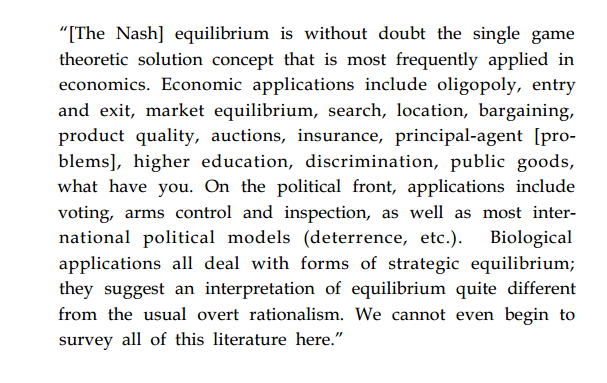The significance is best interpreted in conjunction with Nash's accompanying work.
Myerson gives a good history of the theory: Nash equilibrium and the history of economic theory
Here are some important points:
Thus von Neumann (1928) argued that virtually any competitive game can be modeled by
a mathematical game with the following simple structure: There is a set of players, each player
has a set of strategies, each player has a payoff function from the Cartesian product of these
strategy sets into the real numbers, and each player must choose his strategy independently of the
other players. ...
Von Neumann did not consistently apply this principle of strategic independence,
however. In his analysis of games with more than two players, von Neumann (1928) assumed
that players would not simply choose their strategies independently, but would coordinate their
strategies in coalitions. Furthermore, by his emphasis on max-min values, von Neumann was
implicitly assuming that any strategy choice for a player or coalition should be evaluated against
the other players' rational response, as if the others could plan their response after observing this
strategy choice. Before Nash, however, no one seems to have noticed that these assumptions
were inconsistent with von Neumann's own argument for strategic independence of the players in
the normal form.
Von Neumann (1928) also added two restrictions to his normal form that severely limited
its claim to be a general model of social interaction for all the social sciences: He assumed that
payoff is transferable, and that all games are zero-sum.
In contrast, Nash provided a way to deal with the more general problem of non-transferable utility and non-zero-sum games.
But the most important new contribution of Nash (1951), fully as important as the general
definition and the existence proof of Nash (1950b), was his argument that this noncooperative
equilibrium concept, together with von Neumann's normal form, gives us a complete general
methodology for analyzing all games....
Von Neumann's
normal form is our general model for all games, and Nash's equilibrium is our general solution
concept. ...
Nash (1951) also noted that the assumption of transferable utility can be dropped
without loss of generality, because possibilities for transfer can be put into the moves of the game
itself, and he dropped the zero-sum restriction that von Neumann had imposed.
- Reference: Myerson, Roger B. "Nash equilibrium and the history of economic theory." Journal of Economic Literature 37, no. 3 (1999): 1067-1082.

